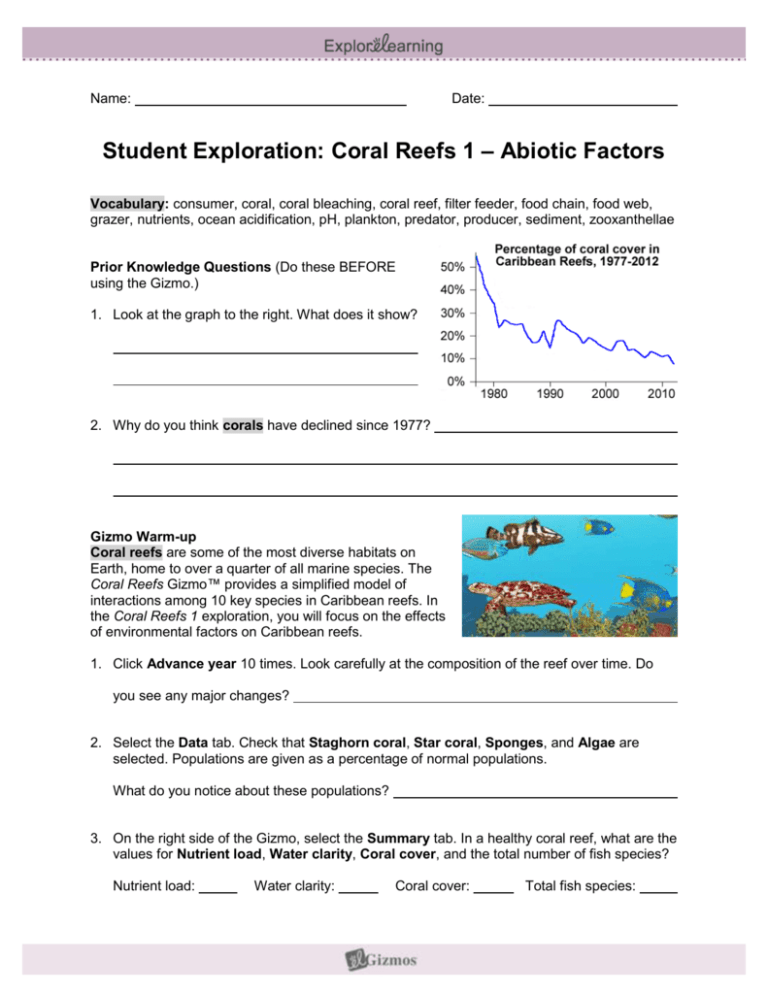Student Exploration: Coral Reefs 1 – Abiotic Factors
advertisement

Name: Date: Student Exploration: Coral Reefs 1 – Abiotic Factors Vocabulary: consumer, coral, coral bleaching, coral reef, filter feeder, food chain, food web, grazer, nutrients, ocean acidification, pH, plankton, predator, producer, sediment, zooxanthellae Prior Knowledge Questions (Do these BEFORE using the Gizmo.) 1. Look at the graph to the right. What does it show? 2. Why do you think corals have declined since 1977? Gizmo Warm-up Coral reefs are some of the most diverse habitats on Earth, home to over a quarter of all marine species. The Coral Reefs Gizmo™ provides a simplified model of interactions among 10 key species in Caribbean reefs. In the Coral Reefs 1 exploration, you will focus on the effects of environmental factors on Caribbean reefs. 1. Click Advance year 10 times. Look carefully at the composition of the reef over time. Do you see any major changes? 2. Select the Data tab. Check that Staghorn coral, Star coral, Sponges, and Algae are selected. Populations are given as a percentage of normal populations. What do you notice about these populations? 3. On the right side of the Gizmo, select the Summary tab. In a healthy coral reef, what are the values for Nutrient load, Water clarity, Coral cover, and the total number of fish species? Nutrient load: Water clarity: Coral cover: Total fish species: Activity A: The Caribbean reef ecosystem Get the Gizmo ready: On the Conditions tab, click Return to original settings. Click Restart. Select the Coral reef tab. Introduction: A healthy Caribbean reef is home to over 50 species of coral and over 400 fish species. In this simplified model, we only consider the interactions of ten important species. Question: How do different species interact in a healthy coral reef? 1. Describe: On the Coral reef tab, click on each organism shown in the table below. For each organism, give its name and what it eats (or how it obtains energy). Picture Name What it eats (or how it obtains energy) 2. Corals obtain energy from tiny photosynthetic algae, called zooxanthellae, which live inside the coral’s tissue. How do you think corals would be affected by cloudy, muddy water? (Activity A continued on next page) Activity A (continued from previous page) 3. Classify: A producer is an organism that makes its own energy, usually from sunlight. A consumer is an organism that gets energy by feeding on other organisms. A. Which of the reef organisms in this Gizmo are producers? B. Which of the reef organisms are consumers? C. Consumers in the reef can be further classified as filter feeders, or organisms that eat plankton by filtering water; grazers, or organisms that feed on organisms that don’t move; and predators, or organisms that eat other animals. List at least one example of each. Filter feeders: Grazers: Predators: 4. Create: A food chain is a series that shows what organisms eat other organisms. For example, the food chain “grass → mouse → hawk” means that the mouse eats grass and the hawk eats the mouse. Create two possible food chains for the Caribbean coral reef based on what you have learned about the ten organisms in this Gizmo. Food chain 1: Food chain 2: 5. Challenge: A food web is a more complicated diagram that shows the feeding relationships of all the organisms in the ecosystem. As with a food chain, an arrow pointing from species A to species B indicates species A is eaten by species B. In the diagram at right, create a food web by drawing arrows to show which organisms are eaten by others.






